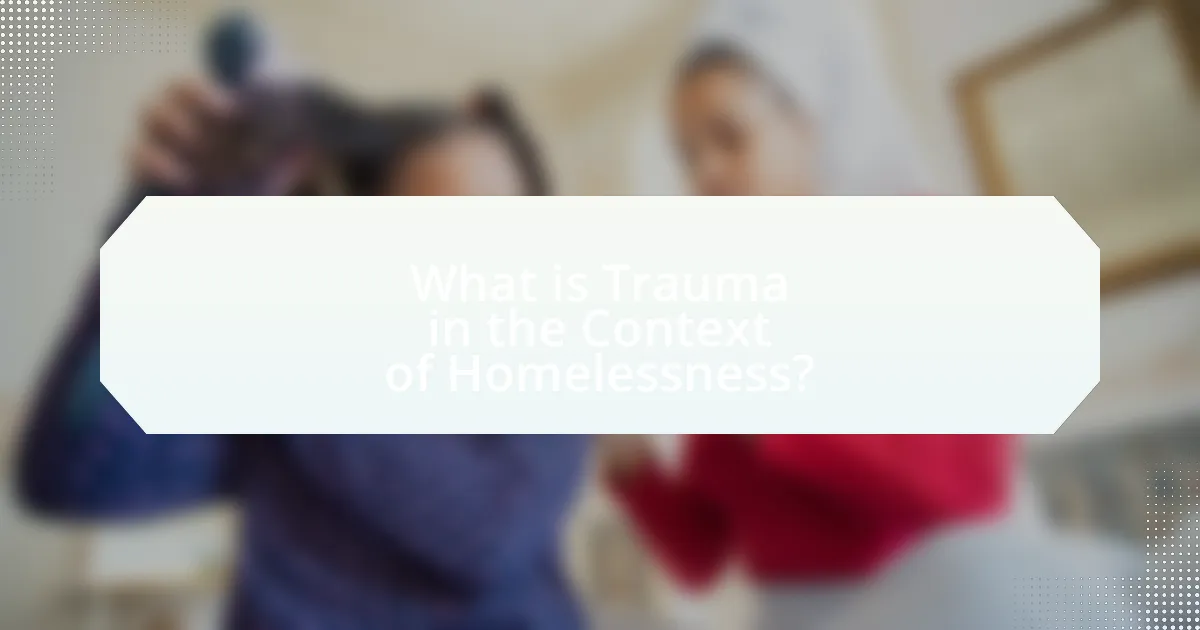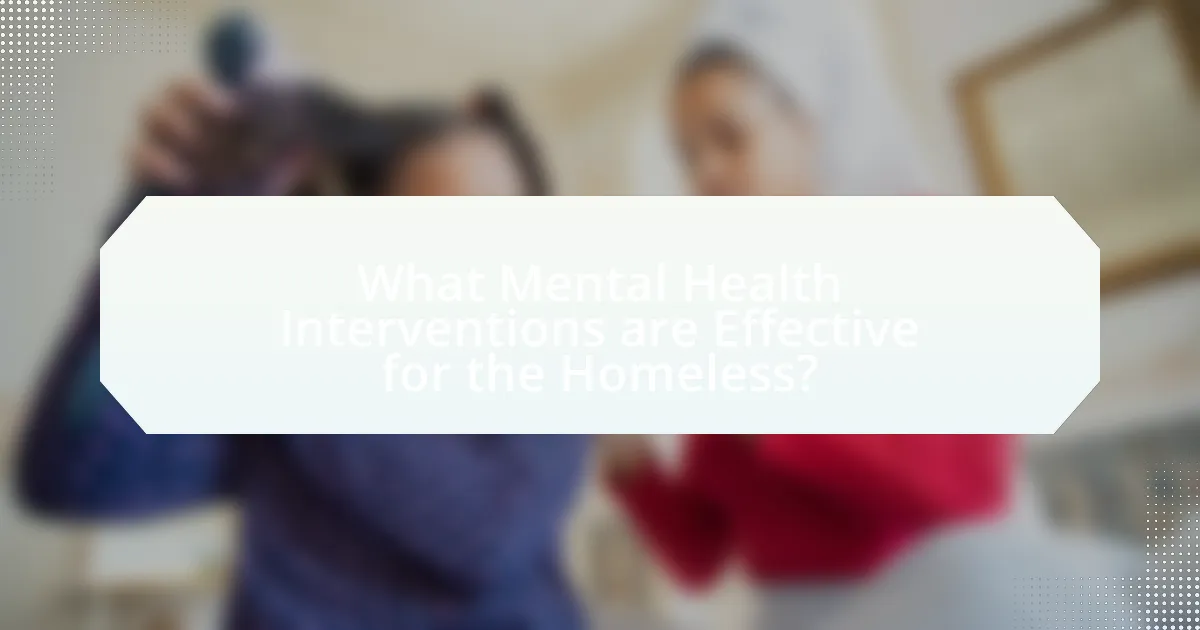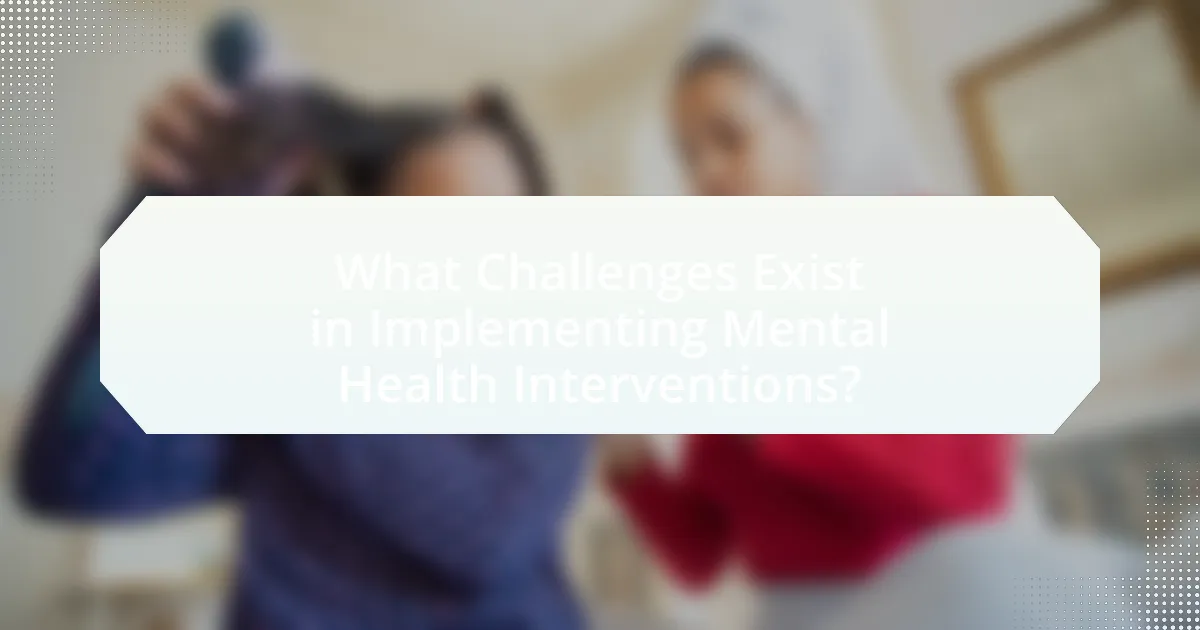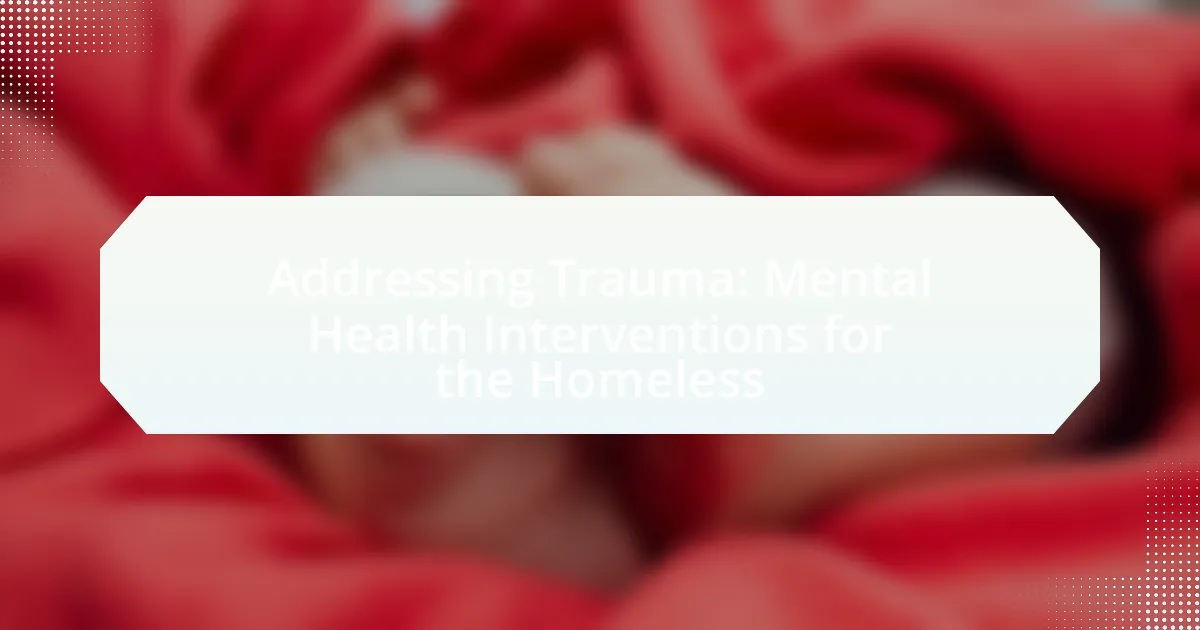The article focuses on the critical issue of trauma in the context of homelessness and its profound impact on mental health. It highlights that approximately 70% of homeless individuals have experienced trauma, which exacerbates mental health disorders such as PTSD, depression, and anxiety. The discussion includes common types of trauma, the behavioral and emotional responses it elicits, and the importance of addressing trauma through effective mental health interventions like trauma-informed care and community-based programs. Additionally, the article outlines the challenges faced in implementing these interventions, including stigma, logistical barriers, and the need for continuous training among service providers to enhance service delivery and improve outcomes for homeless individuals.

What is Trauma in the Context of Homelessness?
Trauma in the context of homelessness refers to the psychological and emotional distress experienced by individuals due to adverse life events, often exacerbated by their living conditions. This trauma can stem from various sources, including childhood abuse, domestic violence, loss of loved ones, and the ongoing stress of living without stable housing. Research indicates that approximately 70% of homeless individuals have experienced some form of trauma, which significantly impacts their mental health and ability to reintegrate into society. The prevalence of post-traumatic stress disorder (PTSD) among this population is notably high, with studies showing rates as high as 30%. Understanding trauma is crucial for developing effective mental health interventions tailored to the unique needs of homeless individuals.
How does trauma affect the mental health of homeless individuals?
Trauma significantly impacts the mental health of homeless individuals by increasing the prevalence of mental health disorders such as depression, anxiety, and post-traumatic stress disorder (PTSD). Research indicates that approximately 70% of homeless individuals have experienced some form of trauma, which can exacerbate existing mental health issues and hinder recovery efforts. The adverse effects of trauma can lead to a cycle of homelessness, as untreated mental health conditions may impair an individual’s ability to secure stable housing and employment. Furthermore, studies show that trauma can alter brain function and stress response systems, making it more challenging for homeless individuals to cope with daily stressors and engage in effective problem-solving.
What are the common types of trauma experienced by the homeless?
The common types of trauma experienced by the homeless include physical trauma, emotional trauma, and complex trauma. Physical trauma often results from violence, accidents, or harsh living conditions, while emotional trauma can stem from loss, abandonment, or chronic stress associated with homelessness. Complex trauma typically arises from prolonged exposure to traumatic events, such as ongoing abuse or neglect, which is prevalent in the lives of many homeless individuals. Research indicates that approximately 70% of homeless individuals have experienced some form of trauma, highlighting the significant impact of these experiences on their mental health and well-being.
How does trauma manifest in behavioral and emotional responses?
Trauma manifests in behavioral and emotional responses through symptoms such as anxiety, depression, anger, and withdrawal. Individuals who have experienced trauma may exhibit hypervigilance, difficulty in trusting others, and emotional dysregulation, which can lead to impulsive behaviors or social isolation. Research indicates that approximately 70% of adults in the U.S. have experienced some type of traumatic event, and many develop post-traumatic stress disorder (PTSD), characterized by intrusive memories and heightened emotional responses. These manifestations can significantly impact daily functioning and relationships, particularly among homeless populations, where the prevalence of trauma is notably high.
Why is addressing trauma crucial for the homeless population?
Addressing trauma is crucial for the homeless population because it directly impacts their mental health and ability to secure stable housing. Trauma often leads to conditions such as PTSD, depression, and anxiety, which can hinder individuals from accessing resources and support systems necessary for recovery. Research indicates that approximately 70% of homeless individuals have experienced significant trauma, which exacerbates their vulnerability and complicates their path to stability. By addressing trauma through targeted mental health interventions, service providers can improve the overall well-being of homeless individuals, facilitating their reintegration into society and reducing the cycle of homelessness.
What are the long-term effects of untreated trauma on mental health?
Untreated trauma can lead to significant long-term effects on mental health, including the development of chronic conditions such as post-traumatic stress disorder (PTSD), depression, and anxiety disorders. Research indicates that individuals who experience untreated trauma are at a higher risk for substance abuse, self-harm, and suicidal ideation. A study published in the Journal of Traumatic Stress found that approximately 70% of individuals with PTSD also experience major depressive disorder, highlighting the interconnectedness of these conditions. Furthermore, untreated trauma can impair emotional regulation and interpersonal relationships, leading to social isolation and difficulties in daily functioning.
How does trauma impact the ability to access services and support?
Trauma significantly hinders the ability to access services and support by creating barriers such as distrust, emotional dysregulation, and avoidance behaviors. Individuals who have experienced trauma often struggle with feelings of shame and fear, which can lead to reluctance in seeking help. Research indicates that trauma can alter brain function, affecting decision-making and emotional responses, making it difficult for individuals to navigate service systems effectively. For instance, a study published in the Journal of Traumatic Stress found that trauma exposure is linked to increased rates of service disengagement among homeless populations, highlighting the critical need for trauma-informed care approaches to facilitate access to necessary support.

What Mental Health Interventions are Effective for the Homeless?
Effective mental health interventions for the homeless include assertive community treatment (ACT), integrated dual disorders treatment (IDDT), and trauma-informed care. ACT provides comprehensive, community-based psychiatric treatment, which has been shown to reduce hospitalization rates and improve overall functioning among homeless individuals with severe mental illness. IDDT addresses both mental health and substance use disorders simultaneously, leading to better recovery outcomes. Trauma-informed care recognizes the impact of trauma on mental health and incorporates strategies that promote safety, empowerment, and healing, which is crucial for this population. Studies indicate that these interventions significantly enhance mental health stability and quality of life for homeless individuals.
How do trauma-informed care approaches work?
Trauma-informed care approaches work by recognizing the widespread impact of trauma on individuals and integrating this understanding into all aspects of service delivery. These approaches prioritize safety, trustworthiness, and empowerment, ensuring that care environments are sensitive to the needs of trauma survivors. Research indicates that trauma-informed care can lead to improved outcomes in mental health services, as it fosters a supportive atmosphere that encourages healing and resilience. For instance, a study published in the Journal of Behavioral Health Services & Research found that implementing trauma-informed practices in homeless shelters significantly improved client engagement and satisfaction.
What principles guide trauma-informed care for the homeless?
Trauma-informed care for the homeless is guided by principles that prioritize safety, trustworthiness, peer support, collaboration, empowerment, and cultural humility. These principles ensure that services are sensitive to the trauma experiences of individuals, fostering an environment where they feel safe and respected. For instance, creating a physically and emotionally safe space helps individuals engage more effectively in their recovery process. Trustworthiness is established through transparent communication and consistent practices, which are crucial for building rapport. Peer support enhances the sense of community and shared experience, while collaboration empowers individuals by involving them in decision-making processes regarding their care. Cultural humility acknowledges and respects the diverse backgrounds of individuals, ensuring that care is relevant and appropriate. These principles are supported by research indicating that trauma-informed approaches improve engagement and outcomes in mental health services for homeless populations.
How can service providers implement trauma-informed practices?
Service providers can implement trauma-informed practices by adopting a framework that recognizes the impact of trauma on individuals and integrates this understanding into their services. This involves training staff to understand trauma’s effects, creating a safe and supportive environment, and fostering trust through transparency and choice. Research indicates that trauma-informed care improves client engagement and outcomes, as evidenced by studies showing reduced symptoms of PTSD and increased satisfaction in service users. For instance, the Substance Abuse and Mental Health Services Administration (SAMHSA) outlines key principles of trauma-informed care, emphasizing safety, trustworthiness, peer support, and empowerment, which are essential for effectively addressing the needs of individuals experiencing homelessness.
What role do community-based programs play in mental health interventions?
Community-based programs play a crucial role in mental health interventions by providing accessible support and resources tailored to the needs of individuals, particularly those experiencing homelessness. These programs foster social connections, reduce stigma, and enhance the overall well-being of participants through peer support, counseling, and skill-building activities. Research indicates that community-based interventions can lead to significant improvements in mental health outcomes; for instance, a study published in the American Journal of Psychiatry found that participants in community-based mental health programs experienced a 30% reduction in symptoms of depression and anxiety. By integrating services within the community, these programs effectively address barriers to care, promote recovery, and empower individuals to manage their mental health in a supportive environment.
How can peer support enhance mental health outcomes for the homeless?
Peer support can enhance mental health outcomes for the homeless by providing a sense of belonging and understanding that traditional mental health services may lack. This form of support fosters trust and encourages individuals to share their experiences, which can lead to improved coping strategies and reduced feelings of isolation. Research indicates that peer support programs can lead to significant reductions in symptoms of depression and anxiety among homeless individuals, as evidenced by a study published in the Journal of Community Psychology, which found that participants in peer support programs reported a 30% decrease in depressive symptoms over six months. Additionally, peer support can facilitate access to resources and services, further promoting recovery and stability in mental health.
What types of therapy are most beneficial for trauma recovery?
Cognitive Behavioral Therapy (CBT), Eye Movement Desensitization and Reprocessing (EMDR), and Trauma-Focused Cognitive Behavioral Therapy (TF-CBT) are the most beneficial types of therapy for trauma recovery. CBT helps individuals identify and change negative thought patterns related to trauma, while EMDR facilitates the processing of traumatic memories through bilateral stimulation, leading to reduced distress. TF-CBT combines cognitive behavioral techniques with trauma-sensitive interventions, making it particularly effective for children and adolescents. Research indicates that these therapies significantly improve symptoms of post-traumatic stress disorder (PTSD) and overall mental health outcomes in trauma survivors, as evidenced by studies published in journals such as the Journal of Traumatic Stress and the American Journal of Psychiatry.

What Challenges Exist in Implementing Mental Health Interventions?
Implementing mental health interventions for the homeless faces several challenges, including limited access to services, stigma, and resource constraints. Limited access arises from geographical barriers and a lack of transportation, making it difficult for homeless individuals to reach mental health facilities. Stigma surrounding mental illness can deter individuals from seeking help, as they may fear judgment or discrimination. Resource constraints, including insufficient funding and a shortage of trained professionals, hinder the development and sustainability of effective interventions. According to a report by the National Alliance on Mental Illness, approximately 20% of homeless individuals experience severe mental illness, highlighting the urgent need for targeted interventions despite these challenges.
What barriers do homeless individuals face in accessing mental health services?
Homeless individuals face significant barriers in accessing mental health services, including lack of stable housing, financial constraints, and stigma. The absence of stable housing often leads to difficulties in maintaining consistent treatment, as many mental health services require appointments that are hard to attend without a permanent address. Financial constraints further complicate access, as many homeless individuals lack insurance or the means to pay for services. Additionally, stigma surrounding mental health issues can deter individuals from seeking help, as they may fear judgment or discrimination. According to the National Coalition for the Homeless, approximately 25% of homeless individuals experience severe mental illness, highlighting the urgent need for accessible mental health services tailored to this population.
How do stigma and discrimination affect service utilization?
Stigma and discrimination significantly reduce service utilization among homeless individuals seeking mental health interventions. Research indicates that negative perceptions associated with mental illness and homelessness lead to feelings of shame and fear, discouraging individuals from accessing necessary services. For instance, a study published in the American Journal of Public Health found that 60% of homeless individuals reported avoiding mental health services due to anticipated stigma. This avoidance results in untreated mental health issues, exacerbating their overall situation and hindering recovery efforts.
What logistical challenges hinder effective intervention delivery?
Logistical challenges that hinder effective intervention delivery include inadequate transportation, limited access to resources, and insufficient coordination among service providers. Inadequate transportation restricts the ability of homeless individuals to reach mental health services, as many lack personal vehicles or funds for public transit. Limited access to resources, such as housing and healthcare facilities, further complicates the delivery of interventions, making it difficult for providers to offer comprehensive support. Additionally, insufficient coordination among service providers can lead to fragmented care, where individuals may receive overlapping services without a cohesive treatment plan, ultimately reducing the effectiveness of mental health interventions.
How can stakeholders collaborate to overcome these challenges?
Stakeholders can collaborate to overcome challenges in addressing trauma and mental health interventions for the homeless by establishing multi-sector partnerships that integrate services. These partnerships can include government agencies, non-profit organizations, healthcare providers, and community groups working together to create comprehensive support systems. For instance, the National Alliance to End Homelessness emphasizes the importance of coordinated entry systems that streamline access to mental health services, housing, and social support, which can significantly improve outcomes for homeless individuals facing trauma. By sharing resources, data, and best practices, stakeholders can enhance service delivery and ensure that interventions are tailored to the specific needs of the homeless population.
What strategies can be employed to improve service accessibility?
To improve service accessibility for mental health interventions for the homeless, implementing mobile outreach programs is essential. These programs bring services directly to individuals in need, reducing barriers such as transportation and stigma associated with visiting facilities. Research indicates that mobile units can increase engagement by up to 50% among homeless populations, as demonstrated in a study published in the American Journal of Public Health, which highlighted the effectiveness of mobile clinics in reaching underserved communities. Additionally, integrating services with existing shelters and community organizations can streamline access, ensuring that individuals receive comprehensive support in familiar environments.
How can funding and resources be optimized for better outcomes?
Funding and resources can be optimized for better outcomes by implementing targeted allocation strategies that prioritize evidence-based mental health interventions for the homeless. Research indicates that programs focusing on trauma-informed care and integrated services yield higher success rates in improving mental health outcomes. For instance, a study published in the American Journal of Psychiatry found that homeless individuals receiving comprehensive mental health services, including counseling and medication management, experienced a 30% reduction in psychiatric symptoms compared to those receiving standard care. Additionally, leveraging data analytics to assess the effectiveness of various programs allows for continuous improvement and reallocation of resources to the most impactful initiatives. This data-driven approach ensures that funding is directed towards interventions that demonstrate measurable success in addressing the mental health needs of the homeless population.
What Best Practices Should Be Followed in Addressing Trauma for the Homeless?
Best practices for addressing trauma in the homeless include trauma-informed care, which emphasizes understanding the impact of trauma on individuals and creating a safe environment. This approach involves training staff to recognize trauma symptoms, fostering trust, and promoting empowerment among clients. Research indicates that trauma-informed care can lead to improved mental health outcomes and increased engagement in services. Additionally, integrating mental health services with housing support has proven effective, as stable housing can significantly reduce trauma-related symptoms. Studies show that individuals with access to both housing and mental health care experience better overall well-being and recovery rates.
How can individualized care plans enhance recovery for homeless individuals?
Individualized care plans enhance recovery for homeless individuals by providing tailored support that addresses their unique needs and circumstances. These plans facilitate a comprehensive approach to mental health and social services, ensuring that each individual receives appropriate interventions based on their specific trauma history, mental health conditions, and personal goals. Research indicates that personalized care can lead to improved engagement in treatment, higher satisfaction with services, and better overall health outcomes. For instance, a study published in the American Journal of Public Health found that homeless individuals with individualized care plans experienced a 30% increase in housing stability and a 25% reduction in emergency room visits, demonstrating the effectiveness of targeted interventions in promoting recovery.
What role does continuous training play in improving service delivery?
Continuous training enhances service delivery by equipping staff with updated skills and knowledge necessary for effective interventions. In the context of mental health interventions for the homeless, ongoing training ensures that service providers are familiar with the latest therapeutic techniques and trauma-informed care practices. Research indicates that organizations that prioritize continuous training experience improved client outcomes, as trained staff can better address the complex needs of individuals facing homelessness and mental health challenges. For instance, a study published in the Journal of Behavioral Health Services & Research found that agencies implementing regular training programs reported a 30% increase in service effectiveness and client satisfaction.

Leave a Reply